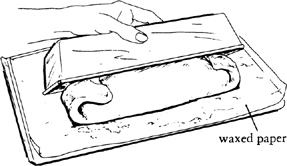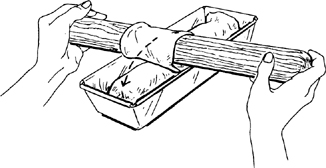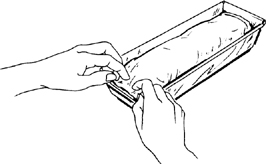Mastering the Art of French Cooking, Volume 2 (130 page)
Read Mastering the Art of French Cooking, Volume 2 Online
Authors: Julia Child

Set in middle level of preheated 425-degree oven and bake for 20 minutes, or until
brioche
has risen about double its height and begun to brown. Turn oven down to 350 degrees for 30–40 minutes more. It is done when you can begin to smell the sausage cooking, and when the
brioche
itself feels solid and makes a rather dry thumping noise when tapped. (Cover lightly with foil or brown paper if it is coloring too much before it is done.) Slide off pastry sheet onto rack, and let cool 20 to 30 minutes before serving.
5)
Serving suggestions
Serve the sausage hot, warm, tepid, or cold (although a sausage is usually better warm or tepid than cold). When serving it hot as a first or main course, you can make a delicious brown sauce with the sausage-poaching liquid, using any of the suggestions in Volume I, pages 73–6.
(*)
AHEAD-OF-TIME NOTES
: You may keep the sausage warm for an hour or more in a 120-degree oven. If for some reason you cannot serve it when baked, let cool, then wrap airtight; reheat uncovered on a lightly buttered pastry sheet in a 400-degree oven for 20 minutes or so.
VARIATIONS
Forming the sausage in a loaf pan
For a 12- by 2-inch sausage you will need the long, rectangular 2-quart pan called an angel loaf, about 12 by 3¼ inches bottom diameter and 2½ inches deep. Follow Steps 1 and 2 in the Master Recipe, butter the inside of the loaf pan, then wrap the hot sausage in the dough on a paper-covered pastry sheet or tray as illustrated.
Turn a buttered 12-inch loaf pan upside down over the sausage. |
|
| Brush off any flour from top of dough, and |
Press dough cover into place with fingers, pushing it lightly down against top, sides, and ends of sausage. |
|
Let rise at a temperature of no more than 75 to 80 degrees for 40 to 60 minutes, until dough is light and springy; it will fill the pan by about three quarters. Glaze, clip top with scissors, and bake as described in preceding Master Recipe.
Baking in a covered pan
When you want to be sure there is no gap between meat and
brioche,
follow the preceding recipe, but rather than glazing and clipping the top of the dough when it has risen, cover the pan as described and illustrated for
pain de mie
. This works because the risen dough fills the pan only by three fourths; then, while it bakes, the dough will not only fill the covered pan completely, but will also press itself against the sausage meat. You may use any shape of pan you wish, including a fluted
brioche
tin. The imported hinged cylindrical mold shown in the illustration can easily be adapted for sausage in
brioche.
Cold pâté en Brioche with Aspic
Sausages, to our mind, are at their best when served hot or warm in
brioche
dough, while liver mixtures are delicious cold. We suggest the
chicken-liver mixture
, or the
cooked pork and liver
pâté
with onions
. Follow any of the preceding methods you wish; when the meat is fully encased and ready to rise, make a hole in the top of the dough and insert a well-oiled cone of foil or the tube from a pastry bag, letting its end touch the meat. After rising and baking, and when completely cold, pour in through the cone as much almost-set wine-flavored meat-jelly aspic as the case will hold. (See illustrated directions in the
pâté en croûte
section
.) Then remove cone, wrap
pâté
airtight, and chill several hours or overnight.
Pâté
should be eaten within 4 to 5 days.
Saucisson en Croûte
[Sausage Baked in Plain Pastry or in Puff Pastry]



